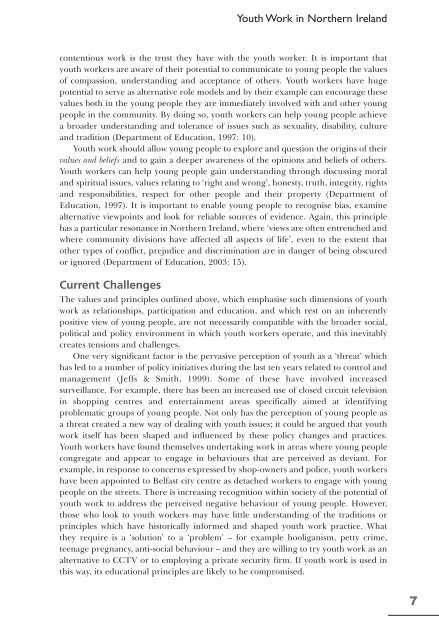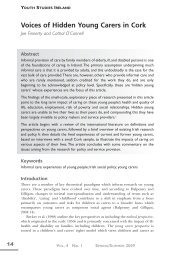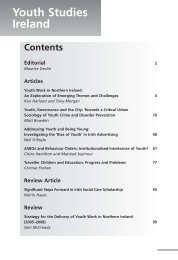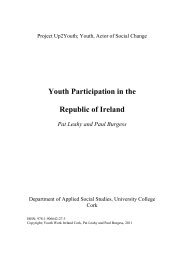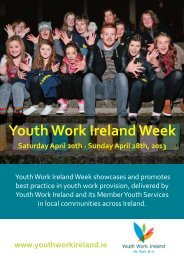Youth Work in Northern Ireland:
Youth Work in Northern Ireland:
Youth Work in Northern Ireland:
Create successful ePaper yourself
Turn your PDF publications into a flip-book with our unique Google optimized e-Paper software.
<strong>Youth</strong> <strong>Work</strong> <strong>in</strong> <strong>Northern</strong> <strong>Ireland</strong>contentious work is the trust they have with the youth worker. It is important thatyouth workers are aware of their potential to communicate to young people the valuesof compassion, understand<strong>in</strong>g and acceptance of others. <strong>Youth</strong> workers have hugepotential to serve as alternative role models and by their example can encourage thesevalues both <strong>in</strong> the young people they are immediately <strong>in</strong>volved with and other youngpeople <strong>in</strong> the community. By do<strong>in</strong>g so, youth workers can help young people achievea broader understand<strong>in</strong>g and tolerance of issues such as sexuality, disability, cultureand tradition (Department of Education, 1997: 10).<strong>Youth</strong> work should allow young people to explore and question the orig<strong>in</strong>s of theirvalues and beliefs and to ga<strong>in</strong> a deeper awareness of the op<strong>in</strong>ions and beliefs of others.<strong>Youth</strong> workers can help young people ga<strong>in</strong> understand<strong>in</strong>g through discuss<strong>in</strong>g moraland spiritual issues, values relat<strong>in</strong>g to ‘right and wrong’, honesty, truth, <strong>in</strong>tegrity, rightsand responsibilities, respect for other people and their property (Department ofEducation, 1997). It is important to enable young people to recognise bias, exam<strong>in</strong>ealternative viewpo<strong>in</strong>ts and look for reliable sources of evidence. Aga<strong>in</strong>, this pr<strong>in</strong>ciplehas a particular resonance <strong>in</strong> <strong>Northern</strong> <strong>Ireland</strong>, where ‘views are often entrenched andwhere community divisions have affected all aspects of life’, even to the extent thatother types of conflict, prejudice and discrim<strong>in</strong>ation are <strong>in</strong> danger of be<strong>in</strong>g obscuredor ignored (Department of Education, 2003: 15).Current ChallengesThe values and pr<strong>in</strong>ciples outl<strong>in</strong>ed above, which emphasise such dimensions of youthwork as relationships, participation and education, and which rest on an <strong>in</strong>herentlypositive view of young people, are not necessarily compatible with the broader social,political and policy environment <strong>in</strong> which youth workers operate, and this <strong>in</strong>evitablycreates tensions and challenges.One very significant factor is the pervasive perception of youth as a ‘threat’ whichhas led to a number of policy <strong>in</strong>itiatives dur<strong>in</strong>g the last ten years related to control andmanagement (Jeffs & Smith, 1999). Some of these have <strong>in</strong>volved <strong>in</strong>creasedsurveillance. For example, there has been an <strong>in</strong>creased use of closed circuit television<strong>in</strong> shopp<strong>in</strong>g centres and enterta<strong>in</strong>ment areas specifically aimed at identify<strong>in</strong>gproblematic groups of young people. Not only has the perception of young people asa threat created a new way of deal<strong>in</strong>g with youth issues; it could be argued that youthwork itself has been shaped and <strong>in</strong>fluenced by these policy changes and practices.<strong>Youth</strong> workers have found themselves undertak<strong>in</strong>g work <strong>in</strong> areas where young peoplecongregate and appear to engage <strong>in</strong> behaviours that are perceived as deviant. Forexample, <strong>in</strong> response to concerns expressed by shop-owners and police, youth workershave been appo<strong>in</strong>ted to Belfast city centre as detached workers to engage with youngpeople on the streets. There is <strong>in</strong>creas<strong>in</strong>g recognition with<strong>in</strong> society of the potential ofyouth work to address the perceived negative behaviour of young people. However,those who look to youth workers may have little understand<strong>in</strong>g of the traditions orpr<strong>in</strong>ciples which have historically <strong>in</strong>formed and shaped youth work practice. Whatthey require is a ‘solution’ to a ‘problem’ – for example hooliganism, petty crime,teenage pregnancy, anti-social behaviour – and they are will<strong>in</strong>g to try youth work as analternative to CCTV or to employ<strong>in</strong>g a private security firm. If youth work is used <strong>in</strong>this way, its educational pr<strong>in</strong>ciples are likely to be compromised.7


